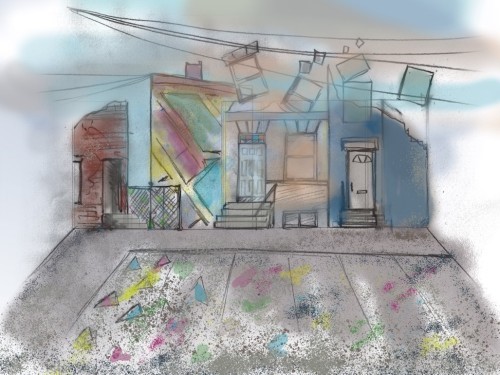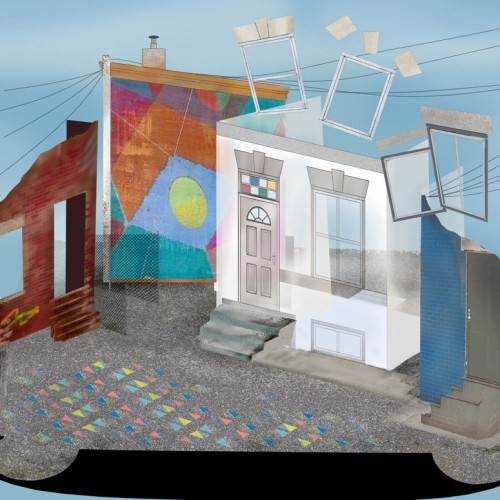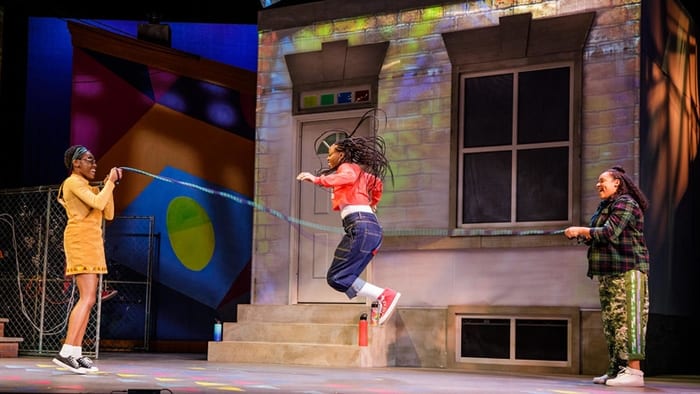Media What I Do
How do artists make decisions about what audiences see and hear on stage? What I Do explores the behind the scenes decisions through eyes of the artists who make them.

How do artists make decisions about what audiences see and hear on stage? What I Do explores the behind the scenes decisions through eyes of the artists who make them.
Scenic Designer Deb Sivigny discusses her process to create the set for Kennedy Center Theater for Young Audiences’ world premiere production of She A Gem by Joshua Wilder.
Deb Sivigny, Scenic Designer
A play’s setting is everything that appears on stage—scenery (background), furniture, and props. “It’s often the first thing in a production that the audience sees,” says Deb Sivigny, who designed the set for She A Gem. Sets can be realistic or fanciful, complex or simple—it all depends on the production needs of the play and the creative vision of director.
Think about:
Deb says, “My job is to interpret where words can’t go.” What are experiences you have had that require something more than words to express them? What are other art forms that tell a story “where words can’t go?”
Imagine you were designing a set based on your own neighborhood. What would you choose to present on stage?
Take a closer look at Deb Sivigny's initial concept sketch for She A Gem! Concept sketches are often freehand drawings and are used by designers as a quick, simple way to illustrate initial design ideas.

Credit: Deb Sivigny
Digital renderings are created using 3-D modeling programs to render a realistic image of a design. Designers use digital renderings to communicate design elements like scale, color, and texture.

Credit: Deb Sivigny
This production photo shows the final scenic design for She A Gem! unter theatrical lights. What elements from the concept sketch, ground plan, and digital rendering can you spot?

Photo: Yassine El Mansouri
Ground Plan
The ground plan shows the exact locations of all scenic elements, including walls, windows, and doors. It communicates exactly what the set will look like to the creative team, actors, and technicians.
Paint Elevations
Paint elevations illustrate the colors and painting techniques the designer intends to use to create the finished look of the set.
Sightlines
Sightlines describe what of the stage is visible from the seats in a theater. They are lines of sight between the audience and the stage.
Wing Space
The wings are part of the stage that are out of sight of the audience, and are typically used for performers preparing to enter, storing scenic elements and/or props, and housing technical equipment such as the fly system.
Downstage
The portion of the stage closest to the audience.
Upstage
The portion of the stage furthest from the audience.
House
The portion of the theater where the audience sits.
Pre-Production
Pre-production describes the planning process in a theatrical production where creative team members like the director, dramaturg, and designers collaborate to create the concept and aesthetic of the show.
For more about the parts of a theater, check out It's Not Just a Stage: A guide to what's what and where's where in a theater.

Video Production Credits:
Logo Design - Jeremy W. Hunter
Green Screen Studio - Gearshift Studio
Filming - 522 Productions
Creative Direction - Patrick W. Lord
Animation and Modeling - Kate Ducey
Editing and Animation - Lacey Erb
Sound Design - Matthew M. Nielson
Kennedy Center Multimedia - Regis Vogt, Georgia Bergin, Trevor Davis
Original Music courtesy of Curious Music Company.
Download the She A Gem production Playbill.
Support for What I Do is provided by A. James & Alice B. Clark Foundation; The Morris and Gwendolyn Cafritz Foundation; and Paul M. Angell Family Foundation.
Generous support is also provided by the U.S. Department of Education.
Learning Content Producers
Dr. Liz Schildkret
Kenny Neal
Learning Content Editor
Tiffany A. Bryant
Updated
December 2, 2020
How do artists make decisions about what audiences see and hear on stage? What I Do explores the behind the scenes decisions through eyes of the artists who make them.
Take a peek behind the red curtain and discover the artistry and history behind the world of theater. Explore the playwriting process first-hand, learn about the cultural impact of performance, and read and perform some of the most influential works of the 20th century.
From providing historical inspiration to preserving cultural traditions to pushing the boundaries of creativity, explore the contributions women have made (and continue to make) to the arts.
Here’s a handy guide to some basic stage directions, the most common parts of a theater, and different types of theater spaces
Generous support for educational programs at the Kennedy Center is provided by the U.S. Department of Education.
Gifts and grants to educational programs at the Kennedy Center are provided by A. James & Alice B. Clark Foundation; Annenberg Foundation; the Andrew W. Mellon Foundation; Bank of America; Bender Foundation, Inc.; Carter and Melissa Cafritz Trust; Carnegie Corporation of New York; DC Commission on the Arts and Humanities; Estée Lauder; Flocabulary; Harman Family Foundation; The Hearst Foundations; the Herb Alpert Foundation; the Howard and Geraldine Polinger Family Foundation; William R. Kenan, Jr. Charitable Trust; the Kimsey Endowment; The King-White Family Foundation and Dr. J. Douglas White; Laird Norton Family Foundation; Lois and Richard England Family Foundation; Dr. Gary Mather and Ms. Christina Co Mather; Dr. Gerald and Paula McNichols Foundation; The Morningstar Foundation; The Morris and Gwendolyn Cafritz Foundation;
Music Theatre International; Myra and Leura Younker Endowment Fund; the National Endowment for the Arts; Newman’s Own Foundation; Nordstrom; Park Foundation, Inc.; Paul M. Angell Family Foundation; Prince Charitable Trusts; Soundtrap; The Harold and Mimi Steinberg Charitable Trust; Rosemary Kennedy Education Fund; The Embassy of the United Arab Emirates; The Victory Foundation; The Volgenau Foundation; and Volkswagen Group of America. Additional support is provided by the National Committee for the Performing Arts.
The content of these programs may have been developed under a grant from the U.S. Department of Education but does not necessarily represent the policy of the U.S. Department of Education. You should not assume endorsement by the federal government.